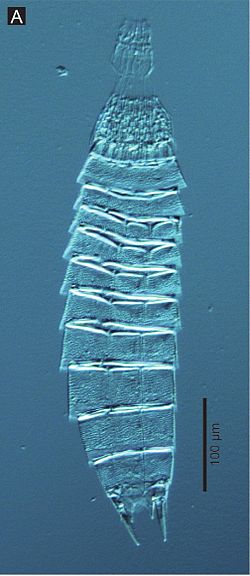| Echinoderes | |
|---|---|
 | |
| Echinoderes hwiizaa | |
| Scientific classification | |
| Kingdom: | Animalia |
| Phylum: | Kinorhyncha |
| Class: | Cyclorhagida |
| Order: | Echinorhagata |
| Family: | Echinoderidae |
| Genus: | Echinoderes Claparède, 1863 [1] [2] |
| Species | |
See text | |
| Synonyms | |
Echinoderella [3] | |
Echinoderes is a genus of mud dragons first described in 1863. [1] It is the largest genus within the phylum Kinorhyncha. [4] It is a highly diverse genus, with member species that inhabit "most marine benthic substrates, on latitudes ranging from the Arctic to the tropics, and from the intertidal zone down to the deep sea." [1] Species on the east coasts of North and South America have been extensively studied by Robert P. Higgins. [1] Species in east Asia have been extensively studied by A. V. Adrianov. [1]
Members of Echinoderes are sexually dimorphic. [5]
Globally Echinoderes are the most diverse, abundant and commonly encountered of all kinorhynch genera. The number of described Echinoderes species has more than doubled since 2002 and it is still increasing in recent years. [6]
Five genera, Echinoderes, Cephalorhyncha, Fissuroderes, Meristoderes, and Polacanthoderes, are currently recognized within the family Echinoderidae. The latter four genera are rather small and accommodate one to nine species only, whereas a vast majority of the diversity is contained in the Echinoderes, that holds more than 100 species.